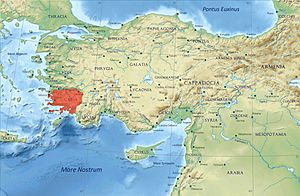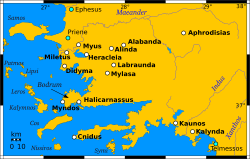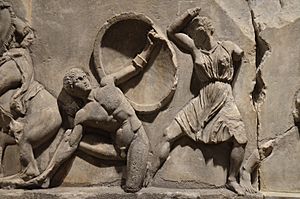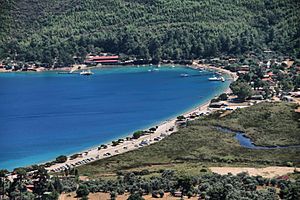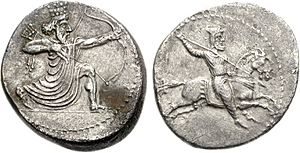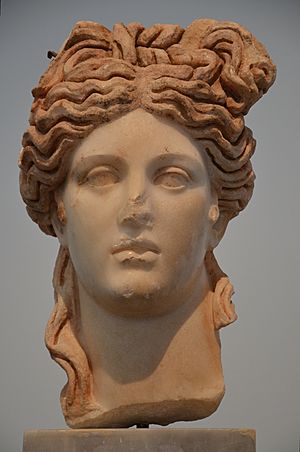Caria facts for kids
Quick facts for kids Caria (Καρία) |
|
|---|---|
| Ancient Region of Anatolia | |
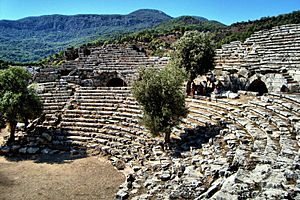
Theater in Caunos
|
|
| Location | Southwestern Anatolia, Turkey |
| State existed | 11th–6th century BC |
| Language | Carian |
| Biggest city | Halicarnassus |
| Roman province | Asia |
Caria (from Greek: Καρία, Karia, Turkish: Karya) was an ancient region in the western part of Anatolia. Today, this area is part of Turkey. Caria stretched along the coast from the middle of Ionia down to Lycia and east to Phrygia.
Greek people from Ionia and Doria settled in the western parts of Caria. They joined the local Carian people to form states that were mostly controlled by Greeks. The ancient historian Herodotus wrote that the Carians were related to the Minoan civilization. However, the Carians themselves believed they were from mainland Anatolia. They were known for being skilled sailors. They also thought they were related to the Mysians and the Lydians.
The Carians spoke the Carian language. This was an Anatolian language that was very similar to Luwian. Another group, the Leleges, were also closely connected to the Carians. Some people think "Leleges" might have been an older name for the Carians.
Contents
Cities of Ancient Caria

Ancient Caria had many towns and cities, especially along its long coastline. These towns show how different groups of people settled there over time.
Coastal Cities
The coastal part of Caria started near Didyma, south of Miletus. Miletus itself was once part of Caria before the Greeks arrived. South of Miletus was a large bay called Iassicus Sinus (now Güllük Körfezi). Here were towns like Iassus and Bargylia.
Further along the coast, on the Bodrum Peninsula, was Myndus. The tip of this peninsula was Cape Termerium, where the town of Termera was located. On the other side was Ceramicus Sinus (now Gökova Körfezi). This gulf used to have many towns.
Halicarnassus, a Greek city, was built here among six Carian towns. These Carian towns included Theangela and Pedasa. Halicarnassus was a very important city.
South of the Bodrum Peninsula was the Carian Chersonnese, also known as Triopium Promontory. This area was named Doris after the Dorian colony of Cnidus.
Even further south was the Rhodian Peraea. This was a coastal area controlled by the island of Rhodes. It included towns like Loryma and Amos. Near the modern town of Marmaris was Physcus, also called Cressa.
The Calbis River (now Dalyan River) marked another important point. On one side was Caunus, an ancient city near modern Dalyan. Some cities in this area, like Calynda, were sometimes considered part of Lydia and sometimes part of Caria.
Inland Cities
Moving inland, away from the coast, you would find the district of Euromus. This area was near modern Milas. Euromus was once called Chrysaoris, a name that sometimes referred to all of Caria. Its towns included Tauropolis and Plarasa. These towns later became part of Mylasa.
Connected to Mylasa by a special road was Labranda. Near Stratonicea, another important inland city, were Lagina and Tendeba.
Further inland, towards modern Aydın, was Alabanda. This city was famous for its marble and its scorpions. Other inland towns included Orthosia and Coscinia.
Where the Maeander and Harpasus rivers met, you would find Harpasa. Another important city was Aphrodisias. This city was first settled by the Leleges. It was sometimes the capital of Caria.
History of Caria
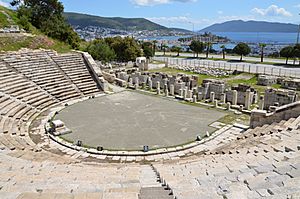
The name "Caria" appears in very old languages. In Hittite, it was "Karkija." In Babylonian, it was "Karsa."
According to the historian Herodotus, a legendary king named Kar founded Caria. His brothers, Lydos and Mysos, founded Lydia and Mysia. This story might have been used to connect the Carians to Greek history. However, the Carians themselves said they were the original people of the mainland. They shared a special temple of Zeus at Mylasa with the Mysians and Lydians, showing they believed they were related.
Caria as a Sovereign State
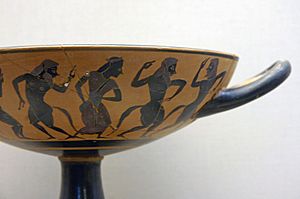
Caria became a kingdom around the 11th century BC. The Dorians arrived in western Anatolia around the 13th century BC. They settled along the coast, taking over older Mycenaean towns like Knidos and Halicarnassus. The famous historian Herodotus was born in Halicarnassus in the 5th century BC.
Greek people also started many new settlements in Caria, both on the coast and inland. These groups of cities often formed local alliances.
Homer's famous poem, the Iliad, mentions that during the Trojan War, the city of Miletus belonged to the Carians. They were allies of Troy.
Caria was also known for its figs. Even today, Caria is a major fig-producing area in Turkey.
Under Lydian and Persian Rule
Around 560-546 BC, the powerful kingdom of Lydia, led by King Croesus, took control of Caria for a short time. But then, the Persian Empire expanded and conquered Lydia, including Caria.
Caria became a Persian province, called a satrapy, in 545 BC. Halicarnassus was the most important city. Its rulers, known as the Lygdamid dynasty, governed from there. Other major towns included Latmus and Aphrodisias. Caria took part in the Ionian Revolt (499–493 BC) against Persian rule.
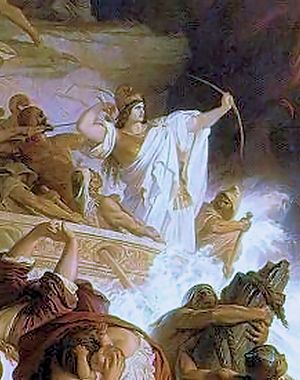
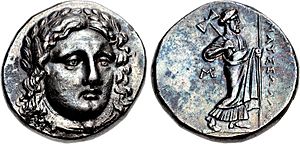
During the Second Persian invasion of Greece (480-479 BC), the cities of Caria were allies of the Persian King Xerxes I. They fought in important battles like the Battle of Salamis. Artemisia, the Queen of Halicarnassus, led 70 Carian ships in this battle.
After the Persian invasion failed, some Carian cities joined the Delian League, which was led by Athens. But they returned to Persian rule around 428 BC. Under Persian rule, a Carian ruler named Mausolus took control of nearby Lycia.
Macedonian Empire
Caria was conquered by Alexander the Great in 334 BC. He was helped by Ada of Caria, a former queen who had been removed from power by the Persians. Ada helped Alexander conquer Caria, and in return, she was made queen again. She then declared Alexander her heir.
Halicarnassus was home to the famous Mausoleum at Halicarnassus. This grand tomb was built for Mausolus, a ruler of Caria from 377–353 BC, by his wife, Artemisia II of Caria. It became one of the Seven Wonders of the Ancient World. The word "mausoleum" comes from his name.
Roman and Byzantine Rule
When Caria became part of the Roman Empire, its name was still used for the region. However, it was administratively part of the Roman province of Asia. In the 4th century, Caria became a separate Roman province.
Christianity was slow to spread in Caria. The region was not visited by St. Paul. The first churches were mainly on the very edge of the region. It seems Christianity only really grew in Caria after it became the official religion in Constantinople.
Turkish Rule
In the 7th century, the old Roman provinces were replaced by a new military system. The region of ancient Caria was taken over by the Turks under the Menteşe Dynasty in the early 13th century.
Later, when the Ottoman Empire took control, most of the population became Muslim and Turkish. The administrative center of the region was moved from Milas to the smaller town of Muğla.
Archaeology
In July 2021, archaeologists found two 2,500-year-old marble statues and an inscription at the Temple of Zeus Lepsynos in Euromus. One statue was naked, and the other wore leather armor and a short skirt. Both statues were shown holding a lion.
Images for kids
-
Carian cities in white. This map depicts the current rivers and coastline and certain features have changed over the years, notably Miletus, Heracleia, and Myus were on the south side of a gulf and Priene on the north side; the river Maeander has since filled in the gulf. Also politically Telmessos, Miletus, and Kalynda were sometimes considered Carian and sometimes not
See also
 In Spanish: Caria para niños
In Spanish: Caria para niños


